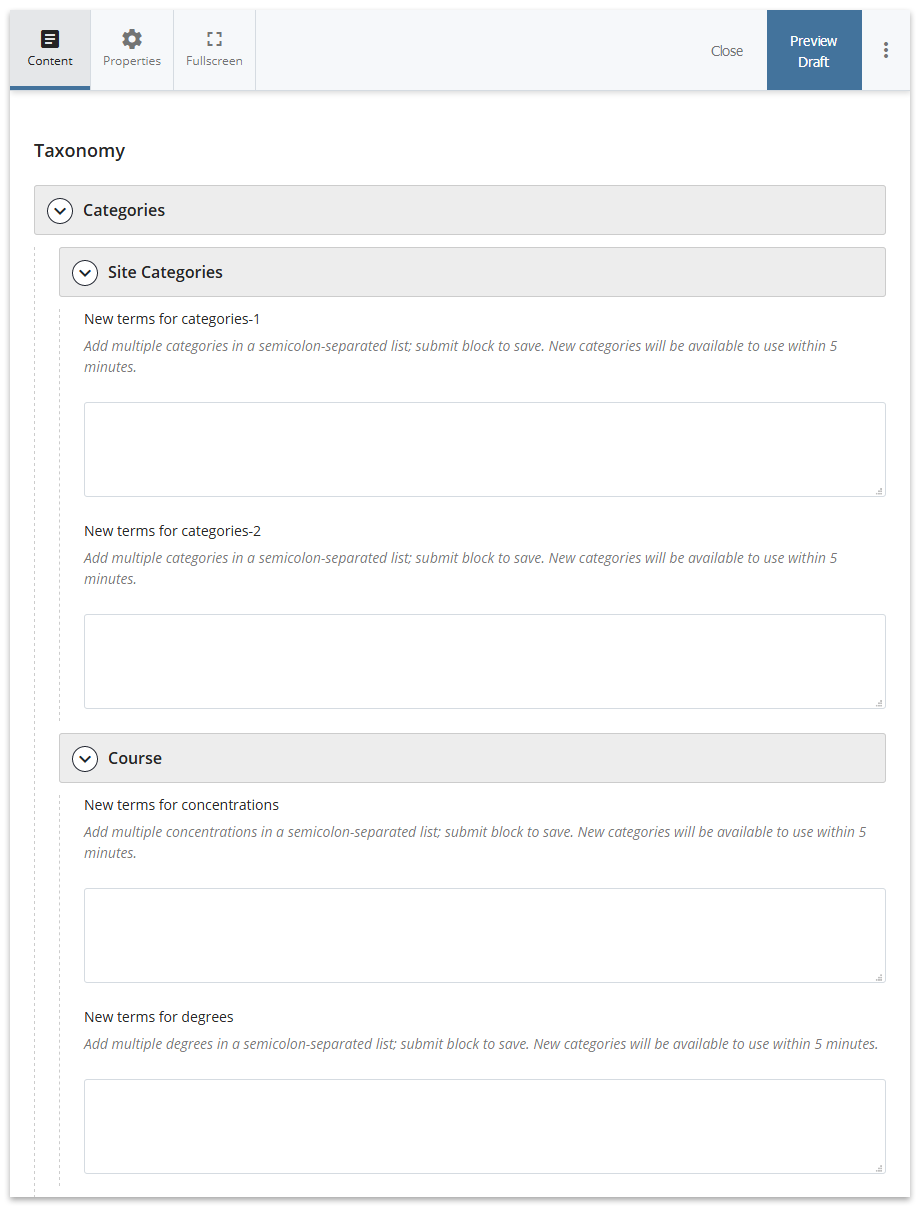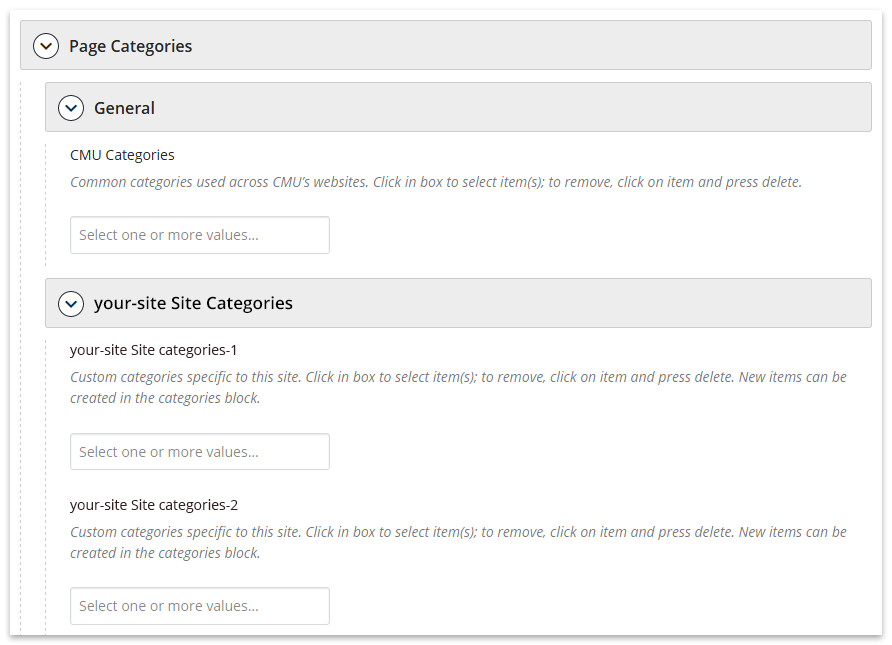Categories, Filters & Dropdowns
Categories provide the ability to be selective about what to include on pages and feeds that are auto-populated with content. Dropdown menus can also be provided for website visitors to filter content by category. Category functionality is available on all of the special page types.
Here's how it works:
1. Add Categories
Every site contains a categories block at the base level. Categories are added to the block in four specific groups; two that are custom topics for your site, two that are related to your courses (Degrees and Concentrations). General CMU categories are also provided (not shown in categories block).
![]()
2. Tag Pages
Special page types (Bio, News Article, Course) are tagged with select categories; choose from the categories added to the categories block, or from a list of general CMU categories commonly used across the university's websites.
3. Apply Filters
Special index page types (Bio Index, News Index, Course Index) and RSS feeds can have a filter applied to only include pages tagged with select categories.
4. Enable Dropdowns
Dropdown menus can be added to special index page types (Bio Index, News Index, Course Index) for category filtering by website visitors. Dropdown filtering is done on the fly, so the page doesn't have to reload!
Follow the step-by-step instructions below to set up categories and use them on your special page types.
Step 1: Add Categories
- Edit the categories block. Categories are grouped as follows (existing categories are displayed if previously added)
- Site Categories
- Categories-1
- Categories-2
- Course
- Concentrations
- Degrees
- Site Categories
- Add a new category by entering the term in the appropriate box; use semicolons to separate multiple categories (e.g., Entrepreneurship;Robots;Pittsburgh Campus)
- After categories have been added to Categories-1 and Categories-2, you will have the option to specify a custom Dropdown Label. These labels will display on the special index page types if the dropdown is added. If not specified, Category 1 and Category 2 will be used as the labels respectively. Examples of custom dropdown labels: Areas of Expertise, Topics, Field of Study.
- Submit to save; new categories will be available to use on your pages within five minutes

Categories block edit interface; fields are available to add new terms to four groups of categories.
Step 2: Tag Pages
When creating or editing a Bio, News Article or Course page, there will be a section for selecting Page Categories.
- Enable the categories you want to tag the page with:
- General CMU Categories commonly used across the university's websites
- Four custom site categories specified in the categories block (Categories-1, Categories-2, Concentrations, Degrees)
- Click in the appropriate box to Select one or more values to tag the page; remove a category from being selected by clicking on it and pressing delete
- Finish editing the page and submit to save

Page categories in the page edit interface.
Step 3: Apply Filters (optional)
When creating or editing a Bio Index, News Index, Course Index page or RSS feed, there will be a section for Filters; filters can be applied so that only pages tagged with specific categories are displayed.
- Enable the filters you want to apply to the page:
- General CMU Categories commonly used across the university's websites
- Four custom site categories specified in the categories block (Categories-1, Categories-2, Concentrations, Degrees)
- Click in the appropriate box to Select one or more values to filter the contents of the page; remove a category from being selected by clicking on it and pressing delete
- Finish editing the page and submit to save, or enable dropdowns (next step)

Filters in the page edit interface.
Step 4: Enable Dropdowns (optional)
When creating or editing a Bio Index, News Index or Course Index page, there will be a section for Dropdowns. Dropdown menus allow category filtering by website visitors, such as filtering by a course number or a professor's name.
- Enable the dropdowns you want to add to the page:
- General CMU Categories commonly used across the university's websites
- Four custom site categories specified in the categories block (Categories-1, Categories-2, Concentrations, Degrees)
- Bio Index page includes a dropdown for Last Name
- Course Index page includes a dropdown for Semesters and Required/Elective
- Finish editing the page and submit to save
Review the special index page types to ensure filtering and dropdowns function as expected; publish relevant pages when ready.

Example of dropdown menus for website visitors; in the example:
- Last Name is available on Bio Index pages only
- Areas of Expertise and Topics are Categories 1 & 2 with custom dropdown labels specified in the categories block
- General CMU Categories are pre-defined categories available to all sites, however only the ones tagged on your pages will be listed in the dropdown. The dropdown label can be customized on a per-page basis.
